#satellite internet providers
Explore tagged Tumblr posts
Text
Exploring the World of Satellite Communication Services
In today’s fast-paced world, staying connected is more crucial than ever. Satellite communication services have revolutionized the way we interact, offering unparalleled connectivity across the globe. From enabling seamless internet access to broadcasting live events, satellite technology plays a pivotal role in our daily lives. In this blog, we’ll delve into the various facets of satellite communication services, including satellite services, satellite internet providers, satellite distribution services, and broadcasting services.
What Are Satellite Communication Services?
Satellite communication services encompass a broad range of technologies and solutions designed to facilitate communication and data transfer via satellites orbiting Earth. These services leverage satellites to provide internet connectivity, broadcast television, and facilitate secure communication channels for both commercial and government use. They are vital for regions where traditional communication infrastructure is lacking or challenging to deploy.
Satellite Services: Bridging the Connectivity Gap
Satellite services include various applications such as satellite phone services, satellite internet, and satellite television. They are crucial for bridging connectivity gaps in remote or underserved areas where terrestrial infrastructure is limited or non-existent. Key benefits of satellite services include:
Global Coverage: Satellites provide near-global coverage, making it possible to connect even the most isolated regions.
Scalability: Services can be easily scaled up or down depending on the needs of the user, from individual users to large organizations.
Reliability: Satellite networks offer high reliability, often providing connectivity where other forms of communication may fail due to natural disasters or infrastructure damage.
Satellite Internet Providers: Bringing the World Online
Satellite internet providers offer a unique solution for high-speed internet access in areas where traditional broadband services are unavailable. Companies such as SpaceX’s Starlink, HughesNet, and ViaSat are leading the charge in satellite internet technology. These providers deploy low Earth orbit (LEO) satellites to deliver faster and more reliable internet service compared to traditional geostationary satellites.
Benefits of satellite internet include:
High-Speed Connectivity: Advances in satellite technology have greatly improved internet speeds, bringing high-speed access to rural and remote areas.
Low Latency: LEO satellites reduce latency compared to traditional satellites, making for a smoother online experience.
Wide Accessibility: Satellite internet can reach locations where other forms of internet connectivity are not feasible.
Satellite Distribution Services: Efficient Data Delivery
Satellite distribution services involve the use of satellites to distribute data and content to multiple locations. This includes everything from television programming to data for weather forecasting. These services ensure efficient and reliable delivery of content to various endpoints, including:
Content Distribution: Satellite distribution networks are used by broadcasters to deliver television channels and media content to cable operators and viewers across the globe.
Data Services: Businesses and governments use satellite data distribution to relay information for applications such as climate monitoring, disaster response, and military operations.
Broadcasting Services: Bringing Information to the Masses
Broadcasting services rely heavily on satellite technology to reach large audiences with television and radio content. Satellite broadcasting provides a wide range of programming, from news and entertainment to educational content. The advantages of satellite broadcasting include:
Wide Reach: Satellite broadcasting covers vast geographical areas, making it possible to reach a global audience.
High Quality: Modern satellite broadcasting provides high-definition content with minimal signal degradation.
Cost-Effective: Satellite broadcasting can be more cost-effective for distributing content over large areas compared to terrestrial networks.
Conclusion
Satellite communication services have become an indispensable part of our global communication infrastructure. Whether it’s connecting remote communities through satellite internet, distributing content via satellite networks, or enabling global broadcasting, satellite technology continues to push the boundaries of connectivity and communication. As technology advances, the capabilities and applications of satellite services will likely expand, further enhancing our ability to stay connected and informed.
#satellite communication services#satellite services#satellite internet providers#satellite distribution services#broadcasting services
0 notes
Text
Understanding VSAT Internet Connections and Satellite Internet Providers
In the digital age, reliable and high-speed internet connectivity is crucial for both individuals and businesses. While traditional broadband services are widely available in urban areas, remote and underserved regions often face challenges in accessing consistent and high-quality internet. This is where VSAT (Very Small Aperture Terminal) internet connections and satellite internet providers come into play. They offer a robust solution to bridge the digital divide, ensuring that even the most isolated locations have access to the internet. In this blog, we'll explore the intricacies of VSAT internet connections and the role of satellite internet providers, while also highlighting the importance of satellite communication services, satellite services, satellite distribution services, and broadcasting services.
What is VSAT Internet?
VSAT, or Very Small Aperture Terminal, is a satellite communication system that enables internet connectivity in remote locations. The term "very small aperture" refers to the size of the antenna used to communicate with satellites. VSAT systems typically consist of a satellite dish, modem, and other necessary equipment to establish a connection with a satellite in geostationary orbit. This connection enables the transmission and reception of data between the satellite and the ground station, providing internet access even in the most remote areas.
How VSAT Internet Connections Work
VSAT internet connections operate by transmitting data from a user’s location to a satellite in orbit. The satellite then relays this data to a central hub, which is connected to the internet backbone. The process is similar in reverse for downloading data, ensuring seamless two-way communication. The satellite acts as a bridge between the remote user and the global internet infrastructure, bypassing the need for traditional ground-based infrastructure like cables or fiber optics.
Advantages of VSAT Internet Connections
1. Global Coverage: One of the primary advantages of VSAT internet connections is their ability to provide global coverage. This makes VSAT an ideal solution for remote areas, maritime vessels, oil rigs, and other locations where traditional internet services are unavailable.
2. Reliability: VSAT connections are known for their reliability, especially in areas where terrestrial networks are prone to disruption. Satellite communication services ensure that users maintain consistent internet access, even in harsh weather conditions.
3. Scalability: VSAT systems are highly scalable, making them suitable for both small businesses and large enterprises. Whether you need connectivity for a single site or multiple locations, VSAT providers can tailor their services to meet your specific needs.
4. Quick Deployment: Unlike terrestrial networks that require extensive infrastructure, VSAT systems can be deployed quickly. This makes them ideal for emergency response situations, temporary setups, and rapid expansion into new markets.
Key Players: Satellite Internet Providers
Satellite internet providers play a critical role in delivering high-speed internet services to remote and underserved areas. These providers offer a range of satellite services, including internet connectivity, broadcasting services, and satellite distribution services. Some of the leading satellite internet providers in the industry include:
1. HughesNet: HughesNet is one of the most well-known satellite internet providers, offering a range of plans tailored to both residential and business customers. With a focus on rural and remote areas, HughesNet delivers reliable internet services through its network of geostationary satellites.
2. Viasat: Viasat provides high-speed satellite internet services to customers across the globe. Known for its fast speeds and large data allowances, Viasat is a popular choice for users in rural areas and those who require robust internet connectivity.
3. SES Networks: SES Networks offers satellite communication services to a wide range of industries, including maritime, aviation, and energy. Their satellite distribution services ensure that customers have access to reliable internet connectivity, regardless of their location.
4. Inmarsat: Inmarsat specializes in providing satellite services to the maritime and aviation sectors. Their VSAT satellite internet solutions offer global coverage, ensuring that vessels and aircraft remain connected even in the most remote regions.
Satellite Communication Services and Their Importance
Satellite communication services are essential for the operation of VSAT systems and satellite internet providers. These services enable the transmission of data between the satellite and ground stations, facilitating internet connectivity, broadcasting, and other communication needs. The key components of satellite communication services include:
1. Satellite Transponders: Transponders are devices on satellites that receive signals from the ground, amplify them, and retransmit them back to Earth. They play a crucial role in maintaining the integrity of the communication link between the satellite and the ground station.
2. Ground Stations: Ground stations are the facilities on Earth that communicate with satellites. They are equipped with antennas, modems, and other equipment necessary for transmitting and receiving data. Ground stations are strategically located to ensure optimal coverage and minimal latency.
3. Network Operations Centers (NOCs): NOCs are responsible for monitoring and managing satellite communication networks. They ensure that the network operates efficiently, troubleshoot any issues, and maintain the overall health of the system.
Satellite Distribution Services and Broadcasting Services
In addition to providing internet connectivity, satellite internet providers also offer satellite distribution services and broadcasting services. These services are essential for delivering television and radio content to a global audience. Satellite distribution services involve the transmission of content from a central location to multiple broadcast stations, ensuring that viewers and listeners receive high-quality content regardless of their location.
Broadcasting services, on the other hand, involve the direct transmission of television and radio signals to end-users via satellite. This method of content delivery is particularly important in regions where traditional broadcasting infrastructure is lacking. Satellite broadcasting services ensure that people in remote areas have access to news, entertainment, and educational content.
Choosing the Right VSAT Providers
When selecting a VSAT provider, it’s important to consider several factors to ensure you get the best service for your needs. Here are some key considerations:
1. Coverage Area: Make sure the provider offers coverage in the region where you need connectivity. Some providers specialize in certain regions, while others offer global coverage.
2. Speed and Bandwidth: Different providers offer varying levels of speed and bandwidth. Choose a provider that meets your requirements for data transfer and internet speed.
3. Service Level Agreements (SLAs): SLAs define the level of service you can expect, including uptime guarantees and support response times. Review these agreements carefully to ensure they align with your expectations.
4. Cost: VSAT services can vary in price depending on the provider and the level of service required. Compare the costs of different providers to find one that fits your budget.
Conclusion
VSAT internet connections and satellite internet providers play a crucial role in ensuring global connectivity, especially in remote and underserved areas. With the ability to provide reliable and high-speed internet, satellite services are an indispensable part of the modern communication landscape. Whether you’re in a remote village, on an oil rig, or aboard a maritime vessel, VSAT providers ensure that you stay connected to the world. By understanding the intricacies of VSAT and the role of satellite communication services, you can make informed decisions about the best solutions for your connectivity needs.
#satellite communication services#satellite services#satellite internet providers#satellite distribution services#broadcasting services#vsat internet#vsat internet connection#vsat providers#vsat satellite internet
0 notes
Text
Sometimes I willingly venture out into the wild (look anywhere other than my blog subs tab) to provide new content to the mutuals (because all I do is reblog their reblogs)
#looking at only mutuals preserves my mental health on the internet#if i see one more ftm vs mtf argument or egg discussion i'm gonna nuke the satellites that provide signal on earth#(genuinely shut the fuck up you're all terminally online)
2 notes
·
View notes
Text
GUESS WHOS FINALLY CANCELING AT&T. GET LOST YOU MONOPOLIZING BASTARDS. This is what I say to your 17 kbps internet in the year fucking 2024: EAAAAAT SHIIIIT. BOOOOO 👎👎👎 BOOOO. No more having utilities threatening to shut off because they don't accept payment in person anymore but we can't fucking connect to their website. No more groceries payments failing to process. No more 'having internet' but 'not actually having internet' because no web page on earth has been capable of loading on only 17 kbps since the fucking 90's. No more 'I'd technically be able to load this page if fucking microsoft windows itself wasn't using what little bandwidth I have to steal my fucking data.' No more having to cancel entire fucking courses because I can't TAKE them anymore. BOOOOOOO. AT&T I hope someone sues your asses to DEATH I hope you die I hope we ALL DIE. You are scum that has prevented us from having internet for DECADES by barring competitors and pocketing infrastructure funds that were supposed to be used to replace lines in a world that literally can no longer function without it because nobody else can even fathom the thought that someone can't go online to pay their own fucking bills. Goodbye thank you and goodnight merry chrysmas
#txt#the BEST gift I couldve asked for#i have a satellite internet provider available now#i looked up reviews saying it 'could be slow during rain'#but then what they meant by slow was 'under 10 mbps'#girl I dont even get ONE#i dont even get ONE MBPS#I only get 1 mbps on the BEST DAT#DAY#and sometimes there goes an entire month or so without a single good day#and i straight up have to go off the grid#TF YOU MEAN 'SLOW'#this is what they do to me. this is how at&t treats my town#and of fucking course they charge us the same as someone receiving high speeds regardless of what they fucking give us#and refuse to replace the lines they were paid to replace#piss oooooffff AT&T I'm OUT#okay sorry got that out of my system#been holding this animosity towards them my entire fucking LIFE#maybe on a good day i will even have fast enough internet to watch a twitch livestream!
0 notes
Text

Unlocking the Best Internet Provider Deals: A Comprehensive Guide
In today's digitally interconnected world, a reliable and high-speed internet connection isn't just a luxury; it's a necessity. Whether you're streaming your favorite shows, conducting business meetings, or gaming with friends, having a robust internet connection can make all the difference. However, with so many providers and packages available, finding the right one for your needs can be overwhelming. That's where Fastway Connect comes in – your trusted partner in navigating the sea of internet options to find the perfect fit for you.
Why Choose Fastway Connect?
At Fastway Connect, we understand that not all internet connections are created equal. That's why we've curated a selection of the best providers and packages to ensure that you get the high-speed internet you need at a price you can afford. Here's why you should choose us:
1. Cheap Internet Deals: We know that price matters. That's why we've scoured the market to find budget-friendly high-speed internet plans for under $50/month. With detailed insights on speed, data caps, and more, we'll help you find the best deal for your budget.
2. Tailored Bundles: Looking for a one-stop-shop for all your entertainment needs? Unlock tailored TV and fast internet bundles based on your location. Our top pick, the AT & T Standard + bundle, offers the ultimate package experience at an unbeatable price.
3. Exclusive Perks: At Fastway Connect, we believe that deals should be more than just promotions – they should be valuable savings over your service term. That's why we've partnered with top local internet providers to uncover exclusive perks that you won't find anywhere else.
Compare and Contrast
Not sure which provider is right for you? Our comprehensive comparison tool makes it easy to compare top-speed internet providers like AT&T, Optimum, and Spectrum. From budget-friendly options like Direct TV to multi-gig possibilities with Frontier and AT&T Fiber, we'll help you find the perfect fit for your needs.
Internet Technology Explained
Understanding the different types of internet technology can help you make an informed decision when choosing a provider. Here's a breakdown of the most common types:
- 5G Home Internet: Utilizes cellphone towers to deliver high-speed internet directly to your home. Offers speeds up to 1,000 Mbps but consistency may vary based on proximity to a cell tower. - Fiber: The swiftest and most dependable option, boasting symmetrical download and upload speeds. Limited availability but offers multi-gigabit plans. - Cable: Widely accessible and highly reliable, with gigabit speeds. May experience slowdowns during peak usage periods. - Fixed Wireless: Offers reliable connectivity for rural regions without the latency issues of satellite options. Expect slower speeds and data caps. - Satellite: Spans all 50 states, offering reliable connectivity for rural areas but with higher latency and lower data allowances. - DSL: Utilizes telephone lines for data transmission, offering widespread availability and affordability but relatively lower speeds.
Guidelines to Selecting Your Ideal Internet Provider
Still not sure where to start? Follow these guidelines to help you make the right choice:
1. Evaluate Your Speed Needs: Take our speed test to gauge your current speed and determine if you require more or less. 2. Consider Device Count and Usage: Factor in the number of connected devices and your daily online activities. 3. Assess Your Current Speed: Test your existing internet speed and seek transparent pricing to understand the actual cost. 4. Demystify Internet Terms: Gain clarity on essential internet concepts to make informed decisions.
Internet Provider FAQs
Still have questions? Here are some frequently asked questions about Fastway Connect:
- Does Fastway Connect provide internet services? We don't directly offer internet services but link you with providers accessible in your area. - Why do limited internet providers serve my area? Limited options often result from the costly infrastructure needed, but we ensure access to top providers. - Will there be new internet choices available in my vicinity? With the rise of 5G and infrastructure investments, we're committed to bringing you cutting-edge options.
In conclusion, finding the best internet provider doesn't have to be complicated. With Fastway Connect, you can unlock exclusive deals, compare top providers, and find the perfect fit for your needs. Say goodbye to slow connections and hello to high-speed internet today!
#internet provider#high-speed internet#internet deals#budget-friendly internet#internet bundles#compare internet providers#exclusive internet perks#internet technology#fiber internet#cable internet#5G internet#DSL internet#satellite internet#fixed wireless internet#internet speed test#internet FAQs#Fastway Connect
0 notes
Text
What Are The Benefits Of Satellite Internet TV Providers In Your Area

In the present digital age, internet connection is required for individual and expert use. Nonetheless, not all regions can get to traditional broadband choices like cable or DSL. This is where satellite internet TV providers become an integral factor. With their capacity to reach even the most far-off regions, satellite internet services offer a suitable solution for people and organizations. Read more:- https://techplanet.today/post/what-are-the-benefits-of-satellite-internet-tv-providers-in-your-area
0 notes
Text
🗣️ This is for all new internet connected cars

A new study has found that your car likely knows more about you than your mom. That is disconcerting, but what’s even more so is what is being done with your information. It’s all about the Benjamins. Our private information is being collected and sold.
The Mozilla Foundation, a non-profit that studies internet and privacy issues, studied 25 car manufacturers. And it found every manufacturer sold in America poses a greater risk to your privacy than any device, app or social media platform.
Our cars are rolling computers, many of which are connected to the internet collecting information about how you drive and where. New cars also have microphones and sensors that give you safety features like automatic braking and drowsy driver detection. Those systems are also providing information. Got GPS or satellite radio? Then your car likely knows your habits, musical and political preferences.
Did you download your car’s app which gives you access to even more features? Well that also gives your car access to your phone and all the information on it.
The study found that of the 25 car brands, 84% say they sell your personal data.
And what they collect is astounding.
One example the study sites is KIA’s privacy policy. It indicates the company collects information about your sexual activity. I initially didn’t believe it until I pulled KIA’s privacy policy and read it. And it’s right there in black and white. It says it collects information about your “ethnicity, religious, philosophical beliefs, sexual orientation, sex life, or political opinions.
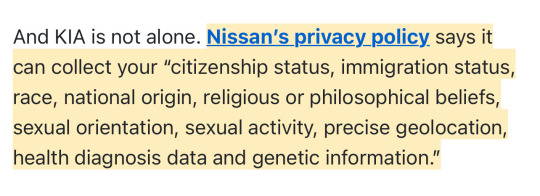
And it says it can keep your info for “as long as is necessary for the legitimate business purpose set out in this privacy notice.”
Translation: Nissan can keep your information as long as they want to. And more than half of the manufacturers (56%) say they will share your information with law enforcement if asked.
(continue reading) more ↵
#politics#data mining#smart cars#spyware#privacy rights#surveillance state#new cars#big brother#nissan#kia#connected cars#consumer alert#panopticon
9K notes
·
View notes
Text
Enjoy Blazing Fast Internet with DirecTV in Virginia Beach, VA

DirecTV is a popular satellite TV service provider that also offers internet services in some areas. In Virginia Beach, VA, DirecTV offers high-speed internet services with speeds up to 100 Mbps. However, availability and pricing may vary depending on your location and specific needs.
If you're interested in signing up for DirecTV internet services in Virginia Beach, VA, I recommend visiting their official website or contacting their customer support to learn more about their available packages, pricing, and promotions. You may also want to compare their services with other internet providers in the area to find the best option for your needs and budget.
The benefits of DirecTV's high-speed internet in Virginia Beach
DirecTV's high-speed internet is a game-changer for residents in Virginia Beach. With speeds up to 100 Mbps, you can stream your favorite shows and movies without any buffering or interruptions. You can also connect multiple devices at once, without any lag or slowdown. Plus, DirecTV's internet service comes with a built-in Wi-Fi network, so you can easily connect all your devices, from your laptop to your smartphone.
How to sign up for DirecTV's internet service in Virginia Beach?
Signing up for DirecTV's internet service in Virginia Beach is easy. Simply visit their website or give them a call to check if the service is available in your area. Once you've confirmed availability, you can choose the package that's right for you and schedule an installation appointment. DirecTV's professional technicians will set up everything for you, including the modem and Wi-Fi network, so you can start enjoying high-speed internet right away.
DirecTV's internet packages and pricing in Virginia Beach
DirecTV offers a variety of internet packages to suit different needs and budgets. Their basic package starts at just $49.99 per month and includes speeds up to 25 Mbps, while their premium package offers speeds up to 100 Mbps and costs $99.99 per month. DirecTV also offers bundle packages that include internet, TV, and phone services, so you can save even more on your monthly bills.
The reliability and customer service of DirecTV's internet in Virginia Beach
DirecTV's internet service is known for its reliability and customer service. They use the latest technology to provide fast and consistent speeds, even during peak usage times. Plus, if you ever have any issues or questions, their customer service team is available 24/7 to help you out. They also offer a variety of resources and tools, such as their online support center and mobile app, to help you manage your account and troubleshoot any issues.
The convenience of DirecTV's internet in Virginia Beach
DirecTV's internet service is designed to be as convenient as possible for residents in Virginia Beach. You can manage your account online, pay your bills, and even stream live TV and on-demand movies through their mobile app. Plus, with their built-in Wi-Fi network, you can easily connect all your devices and enjoy high-speed internet from anywhere in your home. With DirecTV's internet service, you can stay connected and entertained, all at the same time.
In conclusion, residents of Virginia Beach, VA can enjoy high-speed internet with DirecTV. With this service, they can stream their favorite shows and movies, browse the internet, and enjoy online gaming without any lag or interruption. DirecTV offers a reliable and fast internet connection, providing an enjoyable online experience for users in Virginia Beach.
#directv installation virginia beach#directv satellite internet virginia beach#directv deals virginia beach#directv on demand virginia beach#directv stream virginia beach#best satellite tv provider
1 note
·
View note
Text
Amazon Reveals First Satellite Internet Dishes to Compete with Starlink
Amazon has officially announced its first satellite internet dishes as it looks to compete with Elon Musk’s Starlink in the race to provide internet connectivity to remote and underserved regions around the world. The e-commerce giant has been developing its own satellite internet project, codenamed Project Kuiper, since 2019 and recently revealed its first set of antennas. The announcement comes…
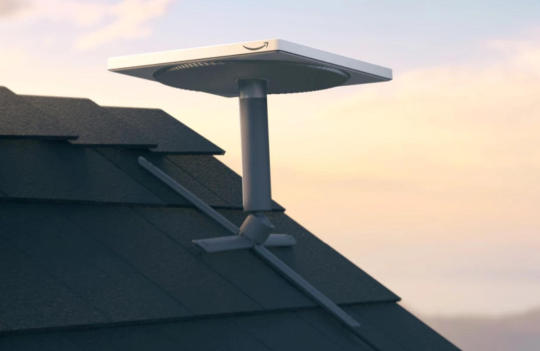
View On WordPress
#affordability#Amazon#customer terminals#data centers#Elon Musk#Global Communication Infrastructure#ground infrastructure#high-speed internet#internet access#internet connectivity#internet service providers#Kuiper Systems#professional installation#Project Kuiper#reliability#remote areas#satellite internet#self-service installation#Starlink#underserved communities
0 notes
Text

Everyone knows a family that has lost a child in Zamzam, a camp for hundreds of thousands of displaced people in Sudan’s Darfur region. Hunger and disease have become grim features of daily life, and a child is dying in the camp every two hours, according to the medical charity Médecins Sans Frontières (MSF). “There have been many, I cannot remember them all. The latest died yesterday,” says Laila Ahmed, who lives in the camp with her nine children. Like most of Sudan, Zamzam has had no phone or internet connection for the past two weeks, but the Guardian managed to talk to refugees through a satellite link.They described a desperate situation, with no clean drinking water and little access to medical treatment. Families share meagre food stores. Almost 25% of children are severely malnourished. Dengue fever and malaria are sweeping through the camp. Beyond its perimeters roam militiamen who kidnap or attack women who venture out to collect firewood or grass for their donkeys. Apart from one small distribution in June, no food aid has arrived since fighting erupted across Sudan on 15 April. “I think we are approaching starvation,” says Abdullatif Ali, a father of six. “The people are suffering from malnutrition, disease – many issues.” Zamzam was set up in the mid-2000s in the wake of the genocide in Darfur, carried out by predominately Arab militias called the Janjaweed. Before the current war between the Sudanese army and the paramilitary Rapid Support Forces (RSF), which grew from the Janjaweed, a patchwork of international aid agencies provided services to Zamzam, but they abruptly pulled out when the fighting started. Since then, the camp’s population has swelled with new arrivals fleeing fighting farther south. “This is a vast, overpopulated camp that needs a large amount of support, but it has been completely left on its own,” says Emmanuel Berbain, an MSF doctor, who visited recently. “It’s a complete catastrophe, to be honest.”
#sudan#keep eyes on sudan#free sudan#sudan genocide#sudan crisis#eyes on sudan#all eyes on sudan#famine#genocide
1K notes
·
View notes
Text
How To Choose The Best Hughesnet Internet Plans in Springfield, MA?

When it comes to selecting the best Hughesnet Internet plans in Springfield, MA, there are a few factors to consider to ensure you're getting the best Hughesnet Internet Plansfor your specific needs.
First and foremost, it's important to check Hughesnet availability in your area. Hughesnet coverage varies depending on location, so you'll want to confirm that the plans you're considering are actually available where you live.
Next, think about what you'll be using your internet service for. If you'll primarily be using it for basic web browsing and email, a lower-speed plan may suffice. However, if you'll be streaming video or playing online games, you'll want to opt for a higher-speed plan to ensure reliable and fast service.
Another important factor to consider is data limits. Many Hughesnet plans cap the amount of data you can use each month before incurring additional charges or having your speeds reduced. Be sure to align the data limit with your usage needs to avoid any unexpected charges or slow down in service.
Ultimately, the best Hughesnet Internet plan for you will depend on your individual needs and budget. Consider these factors and shop around to find the plan that fits your needs and provides the best value.
How sattvforme helps you in choose right Hughesnet Internet Plan in Springfield, MA?
With sattvforme get Hughesnet extensive range of Hughesnet Internet Plans in Springfield, MA, you can choose the plan that best suits your needs. We provide detailed information about all plans, so you can make an informed decision about which plan is right for you. Our team of experts will also help you in understanding the features and benefits of each plan and guide you in selecting the one that meets your requirements. With sattvforme, finding and choosing the right Hughesnet Internet Plan in Springfield, MA is easy and hassle-free!
Call on (888) 797-3141 & choose Hughesnet Internet Plan in Springfield, MA now!
#HUGHESNET#HUGHESNET INTERNET PROVIDERS#SATELLITE INTERNET#HUGHESNET INTERNET BUNDLES#HUGHESNET INTERNET PLANS#HUGHESNET SPRINGFIELD MA
1 note
·
View note
Text
Unlocking the Potential of Satellite Communication Services
In today’s fast-paced world, the need for reliable and high-speed communication is more crucial than ever. Satellite communication services have emerged as a game-changer, offering unparalleled connectivity across the globe. Whether you’re in a bustling city or a remote village, satellite communication can bridge the gap, ensuring that you stay connected no matter where you are.
What Are Satellite Communication Services?
Satellite communication services use satellites in orbit around Earth to provide various forms of communication. These services include satellite internet providers, satellite distribution services, and broadcasting services. By leveraging the power of space technology, these services deliver high-speed internet, broadcast television, and other essential communication needs.
Satellite Internet Providers: Connecting the World
One of the most revolutionary aspects of satellite communication is the rise of satellite internet providers. Traditional internet services often struggle to reach rural and underserved areas. Satellite internet providers step in to fill this gap, offering high-speed internet access to virtually any location on the planet. Whether for personal use or business, satellite internet ensures that connectivity is always within reach.
Satellite Distribution Services: Seamless Connectivity
Satellite distribution services play a crucial role in managing and distributing satellite signals. These services are responsible for transmitting data from satellites to various destinations on Earth. They ensure that the signal is strong, reliable, and reaches the intended audience without interruption. This is particularly important for sectors that rely on continuous data transmission, such as telecommunications and broadcasting.
Broadcasting Services: Bringing the World to Your Screen
Broadcasting services are another vital component of satellite communication. They allow television and radio channels to be transmitted across vast distances. Satellite broadcasting ensures that viewers in remote areas have access to a wide range of channels and programs, just like those in urban centers. This has revolutionized media consumption, making it possible to access content from around the world with ease.
The Future of Satellite Communication
The future of satellite communication looks promising, with advancements in technology paving the way for even more sophisticated services. Next-generation satellites are expected to enhance internet speeds, improve signal reliability, and offer more comprehensive coverage. As technology continues to evolve, satellite communication services will play an increasingly important role in global connectivity.
Conclusion
Satellite services have transformed the way we connect, communicate, and consume media. With satellite internet providers bridging the connectivity gap, satellite distribution services ensuring seamless data transmission, and broadcasting services bringing diverse content to viewers everywhere, the impact of satellite communication is profound and far-reaching. As we look to the future, the continued evolution of this technology promises even greater opportunities for global connectivity and communication.
#satellite communication services#satellite services#satellite internet providers#satellite distribution services#broadcasting services
0 notes
Text

Northtelecom is a Dubai-based company specializing in satellite communication and ICT services and solutions, focusing on innovation and reliability. We provide communication solutions to energy, maritime, media, telco, enterprise, and humanitarian aid industries.
#satellite communication services#satellite services#satellite internet providers#satellite distribution services#broadcasting services#vsat internet#vsat internet connection#vsat providers#vsat satellite internet
0 notes
Text
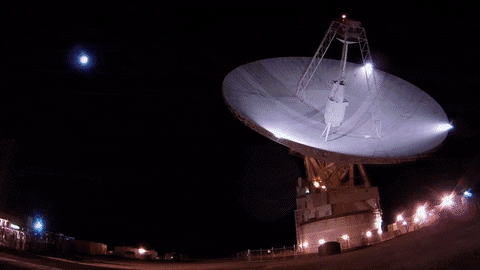
9 Out-of-This-World Moments for Space Communications & Navigation in 2023
How do astronauts and spacecraft communicate with Earth?
By using relay satellites and giant antennas around the globe! These tools are crucial to NASA’s space communications networks: the Near Space Network and the Deep Space Network, which bring back science and exploration data every day.
It’s been a great year for our space communications and navigation community, who work to maintain the networks and enhance NASA’s capabilities. Keep scrolling to learn more about our top nine moments.

The SpaceX Falcon 9 rocket carrying the Dragon spacecraft lifts off from Launch Complex 39A at NASA's Kennedy Space Center in Florida on Thursday, Nov. 9, 2023, on the company's 29th commercial resupply services mission for the agency to the International Space Station. Liftoff was at 8:28 p.m. EST.
1. In November, we launched a laser communications payload, known as ILLUMA-T, to the International Space Station. Now, ILLUMA-T and the Laser Communications Relay Demonstration (LCRD) are exchanging data and officially complete NASA’s first two-way, end-to-end laser relay system. Laser communications can send more data at once than traditional radio wave systems – think upgrading from dial-up to fiber optic internet. ILLUMA-T and LCRD are chatting at 1.2 gigabits per second (Gbps). At that rate, you could download an average movie in under a minute.

NASA’s InSight lander captured this selfie on Mars on April 24, 2022, the 1,211th Martian day, or sol, of the mission.
2. Data analyzed in 2023 from NASA’s retired InSight Mars lander provided new details about how fast the Red Planet rotates and how much it wobbles. Scientists leveraged InSight’s advanced radio technology, upgrades to the Deep Space Network, and radio signals to determine that Mars’ spin rate is increasing, while making the most precise measurements ever of Mars’ rotation.
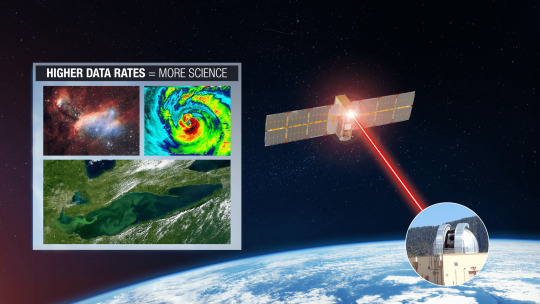
TBIRD is demonstrating a direct-to-Earth laser communications link from low Earth orbit to a ground station on Earth.
3. We set a new high record! The TeraByte InfraRed Delivery (TBIRD) payload – also demonstrating laser communications like ILLUMA-T and LCRD – downlinked 4.8 terabytes of data at 200 Gbps in a single 5-minute pass. This is the highest data rate ever achieved by laser communications technology. To put it in perspective a single terabyte is the equivalent of about 500 hours of high-definition video.
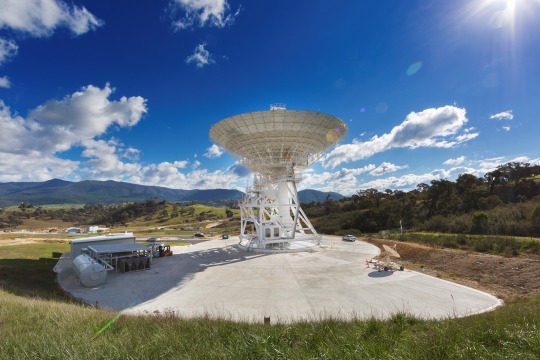
A 34-meter (112-foot) wide antenna at Canberra Deep Space Communications Complex near Canberra, Australia.
4. This year we celebrated the Deep Space Network’s 60th anniversary. This international array of antennas located at three complexes in California, Spain, and Australia allow us to communicate with spacecraft at the Moon and beyond. Learn more about the Deep Space Network’s legacy and future advancements.
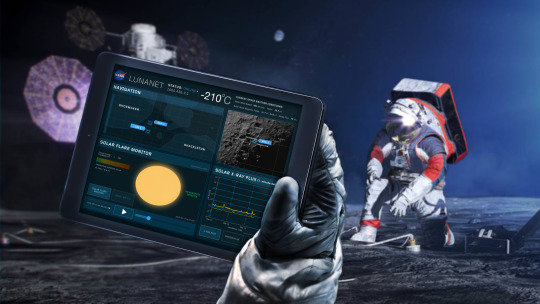
An illustration of the LunaNet architecture. LunaNet will bring internet-like services to the Moon.
5. We are bringing humans to the Moon with Artemis missions. During expeditions, astronauts exploring the surface are going to need internet-like capabilities to talk to mission control, understand their routes, and ensure overall safety. The space comm and nav group is working with international partners and commercial companies to develop LunaNet, and in 2023, the team released Draft LunaNet Specification Version 5, furthering development.
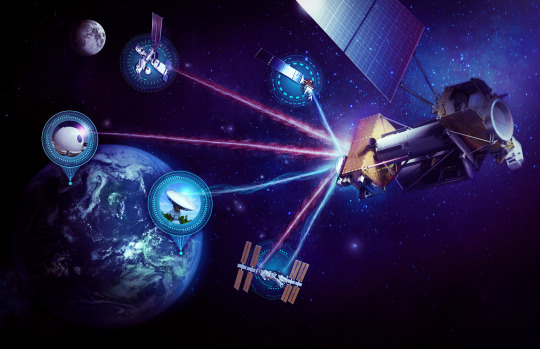
The High-Rate Delay Tolerant Networking node launched to the International Space Station in November and will act as a high-speed path for data.
6. In addition to laser communications, ILLUMA-T on the International Space Station is also demonstrating high-rate delay/disruption tolerant networking (HDTN). The networking node is showcasing a high-speed data path and a store-and-forward technique. HDTN ensures data reaches its final destination and isn’t lost on its path due to a disruption or delay, which are frequent in the space environment.

The Communications Services Project (CSP) partners with commercial industry to provide networking options for future spaceflight missions.
7. The space comm and nav team is embracing the growing aerospace industry by partnering with commercial companies to provide multiple networking options for science and exploration missions. Throughout 2023, our commercialization groups engaged with over 110 companies through events, one-on-one meetings, forums, conferences, and more. Over the next decade, NASA plans to transition near-Earth services from government assets to commercial infrastructure.

Middle and high school students solve a coding experiment during NASA's Office of STEM Engagement App Development Challenge.
8. Every year, NASA’s Office of STEM Engagement sponsors the App Development Challenge, wherein middle and high school students must solve a coding challenge. This year, student groups coded an application to visualize the Moon’s South Pole region and display information for navigating the Moon’s surface. Our space communications and navigation experts judged and interviewed students about their projects and the top teams visited NASA’s Johnson Space Center in Houston!
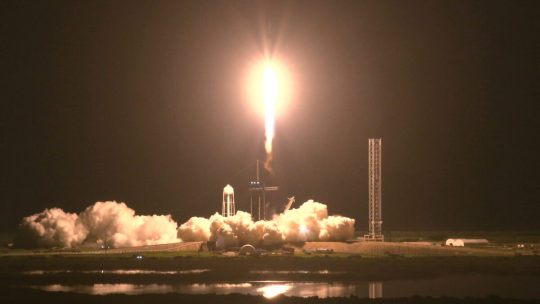
A SpaceX Falcon 9 rocket soars upward after liftoff at the pad at 3:27 a.m. EDT on Saturday, Aug. 26, from Kennedy Space Center’s Launch Complex 39A in Florida carrying NASA’s SpaceX Crew-7 crew members to the International Space Station. Aboard SpaceX’s Dragon spacecraft are NASA astronaut Jasmin Moghbeli, ESA (European Space Agency) astronaut Andreas Mogensen, JAXA (Japan Aerospace Exploration Agency) astronaut Satoshi Furukawa, and Roscosmos cosmonaut Konstantin Borisov.
9. The Near Space Network supported 19 launches in 2023! Launches included Commercial Crew flights to the International Space Station, science mission launches like XRISM and the SuperBIT balloon, and many more. Once in orbit, these satellites use Near Space Network antennas and relays to send their critical data to Earth. In 2023, the Near Space Network provided over 10 million minutes of communications support to missions in space.
Here’s to another year connecting Earth and space.
Make sure to follow us on Tumblr for your regular dose of space!
1K notes
·
View notes
Text
We’ve just taken a major step toward cleaning up space junk.
On Monday, October 2, the Federal Communications Commission (FCC) in the US issued its first fine for space debris, ordering the US TV provider Dish to pay $150,000 for failing to move one of its satellites into a safe orbit.
“It is definitely a very big symbolic moment for debris mitigation,” says Michelle Hanlon, a space lawyer at the University of Mississippi. “It’s a great step in the right direction.”
But it might be more than just a symbolic gesture by the FCC. Not only does it set a precedent for tackling bad actors who leave dangerous junk orbiting Earth, but it could send shock waves through the industry as other satellite operators become wary of having their reputation tarnished. While the $150,000 FCC fine was modest, Dish’s share price fell by nearly 4% immediately following its announcement, pushing the company’s $3 billion valuation down about $100 million.
The FCC’s action could also help breathe new life into the still-small market for commercial removal of space debris, essentially setting a price—$150,000—for companies such as Astroscale in Japan and ClearSpace in Switzerland to aim for in providing services that use smaller spacecraft to sidle up to dead satellites or rockets and pull them back into the atmosphere...
Another hope is that the FCC’s fine will encourage other countries to follow suit with their own enforcement actions on space junk. “It sends a message out of America taking leadership in this area,” says Newman. “This is starting the ball rolling.”
Today there are more than 8,000 active satellites, nearly 2,000 dead satellites, and hundreds of empty rockets orbiting Earth. Managing these objects and preventing collisions is a huge task, and one that is becoming increasingly difficult as the number of satellites grows rapidly. The worsening situation is largely due to mega-constellations of hundreds or thousands of satellites from companies like SpaceX and Amazon, designed to beam the internet to any corner of the globe...
Hanlon says there are further measures that could be taken to discourage companies from failing to dispose of satellites properly. “Honestly, I would love to see that if you don’t meet your license requirements, you’re banned from launching for a number of years,” she says. “If you’re driving under the influence you can have your license revoked. These are the kinds of measures we need to see.”
Chris Johnson, a space law advisor at the Secure World Foundation in the US, says the loss of reputation for Dish about the satellite situation might be worse than any fine it could have received. “They promised to remove it and they didn’t,” he says. “It’s like the first operator of a car to get a speeding ticket.”
The fall in the company’s share price appears to be indicative of that reputational damage. The fine may not have been as severe as it could have been, but the FCC’s actions can be seen as a warning to other companies to tackle space junk. “This is going to be on their record and their reputation,” says Johnson. “It’s not trivial.”
-via MIT Technology Review, October 5, 2023
Always nice to see steps taken to tackle a problem BEFORE it causes incredibly massive issues
791 notes
·
View notes
Text
Connecting the World: Telecommunications Satellites Enhance Global Communication Networks

In an increasingly interconnected world, the role of telecommunications has never been more critical. The rapid growth of digital communication technologies has significantly transformed the way we live, work, and interact with one another. At the heart of this transformation lies a technology that orbits high above us – telecommunications satellites. These sophisticated machines play a pivotal role in bridging gaps across continents, bringing people closer, and enabling the seamless exchange of information on a global scale.
Telecommunications satellites are the backbone of modern communication networks. These satellites are designed to transmit signals across vast distances, overcoming the limitations of terrestrial infrastructure. By relaying signals from one point on the Earth's surface to another, they enable instant communication, regardless of geographical barriers. This capability has revolutionized various sectors, from media broadcasting to internet services, emergency communications, and more.
The Evolution of Telecommunications Satellites
The journey of telecommunications satellites began in the mid-20th century. Early experiments with satellite communication laid the groundwork for what would become a global network. The launch of the first artificial satellite, Sputnik, in 1957 marked the dawn of the space age. However, it wasn't until the launch of the first geostationary satellite in 1965 that the true potential of satellite communication was realized. This satellite, positioned in a fixed location relative to the Earth's surface, could provide continuous coverage to a specific region, paving the way for real-time communication across the globe.
Since then, telecommunications satellites have evolved dramatically. Advances in technology have led to the development of more sophisticated satellites with greater capacity, reliability, and efficiency. Modern satellites are equipped with high-powered transponders, enabling them to handle large volumes of data transmission. These advancements have expanded the capabilities of satellite communication, making it an indispensable part of the global communication network.
How Telecommunications Satellites Work
The operation of telecommunications satellites is based on the principles of radio frequency transmission. These satellites receive signals from ground-based stations, amplify them, and retransmit them back to other ground stations. The process involves several key components:
Uplink: The transmission of signals from a ground station to the satellite. This is typically done using high-frequency radio waves.
Transponder: The component within the satellite that receives the uplink signal, amplifies it, and changes its frequency for retransmission.
Downlink: The transmission of signals from the satellite back to a ground station. This completes the communication loop, allowing the original signal to reach its intended destination.
Satellites are positioned in different orbits depending on their specific functions. Geostationary satellites, which orbit at approximately 35,786 kilometers above the equator, provide continuous coverage to specific regions. Low Earth orbit (LEO) satellites, positioned much closer to the Earth's surface, offer lower latency and are often used for services requiring real-time data transmission, such as internet connectivity.
Impact on Global Communication Networks
The impact of telecommunications satellites on global communication networks is profound. They have enabled a level of connectivity that was previously unimaginable, facilitating the seamless exchange of information across vast distances. Here are some key areas where their impact is most evident:
Media and Broadcasting
Telecommunications satellites have revolutionized the media and broadcasting industry. They enable the transmission of television and radio signals to remote and underserved areas, ensuring that people worldwide have access to information and entertainment. Live broadcasts of major events, such as sports competitions and political speeches, are made possible through satellite technology, allowing audiences to experience these moments in real time.
Internet Connectivity
In many parts of the world, terrestrial internet infrastructure is either insufficient or nonexistent. Telecommunications satellites provide a vital solution to this problem by offering internet connectivity to remote and rural areas. Satellite internet services have become increasingly popular, providing reliable and high-speed internet access to communities that were previously disconnected.
Emergency Communications
During natural disasters and emergencies, terrestrial communication networks are often disrupted. Telecommunications satellites play a crucial role in providing emergency communication services, ensuring that rescue and relief operations can be coordinated effectively. Satellite phones and portable satellite communication devices are essential tools for first responders and humanitarian organizations, enabling them to maintain communication in even the most challenging conditions.
Global Navigation Systems
Telecommunications satellites are also integral to global navigation systems. They provide the precise timing and positioning data required for navigation and location-based services. These systems are essential for various applications, including aviation, maritime, and land transportation, as well as for personal navigation devices used by millions of people worldwide.
Future Trends and Developments
The field of telecommunications satellites is continually evolving, driven by advancements in technology and increasing demand for connectivity. Several trends and developments are shaping the future of this industry:
High Throughput Satellites (HTS)
High throughput satellites represent a significant advancement in satellite technology. These satellites offer substantially increased data transmission capacity, enabling faster and more reliable communication services. HTS technology is particularly beneficial for providing broadband internet access to remote and underserved areas, helping to bridge the digital divide.
Constellations of LEO Satellites
One of the most exciting developments in satellite communication is the deployment of constellations of low Earth orbit satellites. These constellations consist of hundreds or even thousands of small satellites working together to provide global coverage. LEO constellations offer lower latency and higher data transfer rates compared to traditional geostationary satellites, making them ideal for applications such as internet of things (IoT) connectivity and real-time data services.
Advances in Satellite Manufacturing
Advances in satellite manufacturing are making it possible to produce smaller, more cost-effective satellites. These miniaturized satellites, often referred to as smallsats or cubesats, can be launched in large numbers, providing flexible and scalable communication solutions. The reduced cost of manufacturing and launching these satellites is driving innovation and enabling new players to enter the market.
Integration with Terrestrial Networks
The integration of satellite communication with terrestrial networks is another key trend. Hybrid networks that combine satellite and terrestrial technologies can offer seamless connectivity, ensuring that users have access to reliable communication services regardless of their location. This integration is particularly important for providing consistent internet coverage in areas with challenging terrain or sparse infrastructure.
Challenges and Considerations
While telecommunications satellites offer numerous benefits, there are also challenges and considerations to address. One of the primary challenges is the cost associated with launching and maintaining satellites. The development, launch, and operation of satellites require significant investment, which can be a barrier for some organizations.
Additionally, the increasing number of satellites in orbit raises concerns about space debris and collision risks. Ensuring the long-term sustainability of space activities requires careful management of satellite operations and the implementation of measures to mitigate the risk of space debris.
Conclusion
Telecommunications satellites have fundamentally transformed global communication networks, enabling instant connectivity and information exchange across vast distances. From media broadcasting and internet connectivity to emergency communications and global navigation, the impact of these satellites is far-reaching and profound.
As technology continues to advance, the future of telecommunications satellites looks promising. High throughput satellites, LEO constellations, and advancements in satellite manufacturing are set to further enhance the capabilities of satellite communication. By overcoming challenges and embracing innovation, telecommunications satellites will continue to play a crucial role in connecting the world, bridging gaps, and enabling a more connected and informed global community.
In a world where connectivity is essential, telecommunications satellites stand as a testament to human ingenuity and the relentless pursuit of progress. They embody the spirit of exploration and innovation, bringing people closer together and fostering a sense of global unity. As we look to the future, the continued evolution of telecommunications satellites promises to unlock new possibilities and drive the next wave of communication advancements.
196 notes
·
View notes